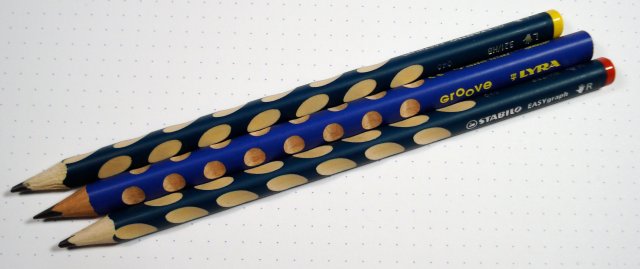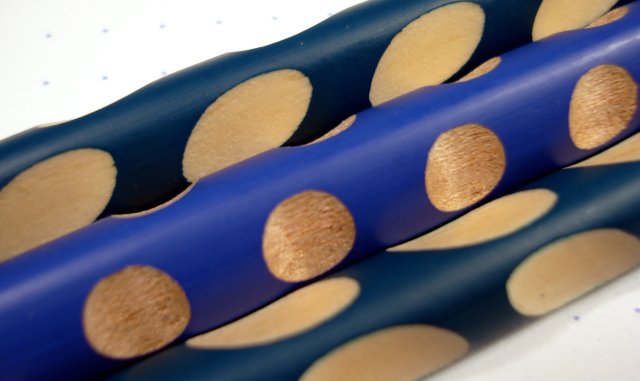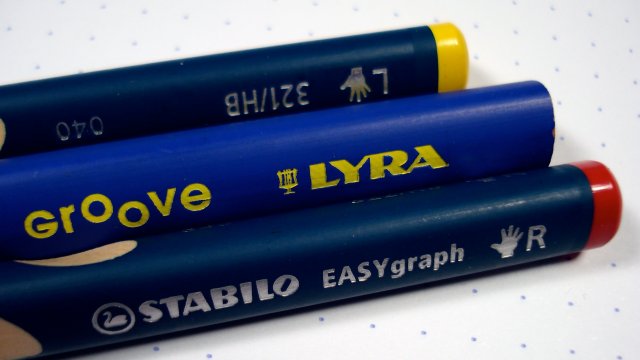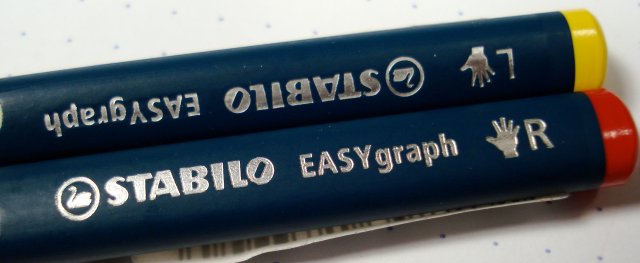
A new pencil trend – scallops or grooves cut into finished triangular pencils, exposing the underlying wood. Seen here, the Stabilo EASYgraph (right and left hand versions) and the LYRA Groove. Lexikaliker reports that Koh-I-Noor will be introducing a similar product in 2011.
Aimed at children, the idea is that the grip is improved, facilitating a good grasp and writing technique.
I wonder, what do the manufacturers do with the excavated pieces?

Comparing the two pencils, the Groove seems relatively simple – round scoops. The EASYgraph comes in two versions, right and left handed, with oval indentations matching the “correct writing grip”. The EASYgraph did feel much more comfortable in my hand.

The EASYgraph also has something very unusual – the lettering in different orientations according to the handedness of the pencil:

For writing, the Groove seemed quite rough and scatchy, while the EASYgraph was comparatively smooth.
My sincere thanks to Gunther from Lexikaliker, who sent all three of these pencils to me eons ago.

you make them look nice, good photos.
I have tried the Stabilo version – they’re nice enough, but rather expensive. IMHO pencils for lefthanders is overdoing it a bit…
regards Henrik
I hope the manufacturers do use the excavated pieces. Maybe they can make MDF from them.
The machinery that creates these grooves is a cutting tool that generates shavings and wooddust particles similar to the shaping and grooving process. Given the size of the market for these pencils the volume generation will be quite low relative to whats generated from shaping and grooving of all wood pencils in any given factory. So most likely these just get consolidated with other waste generated from the inital grooving step through to final factory sharpening process. Uses of wod waste by-products in Pencil factories vary from producer to producer around the world. This could be anything from burning on site for heat or energy, peletizing or extruding for efficient transport and sale as a fuel source, to animal bedding material, etc. The presence of pieces of color pigments and graphite core and lacquer do have some impact on ultimate use depending upon location in the world. Walking horse farms in Tennessee used to use alot of this but didn’t like it when the material got wet and the horses would turn different colors from color pencil trim ends. Staedtler may use thier wood waste as part of the wood flour raw material to produce their Wopex extruded plastic-wood composite pencil. I am not exactly sure of this. Other than for extrudeed plastic pencil use I doubt any significant volume is used to produce any form of engineered wood product such as MDF. The majority of pencil factory wood waste on a world wide basis is likely used for some form of heat/energy source.
Henrik and Matthias, thank you for the comments.
WoodChuck, thank you for that detailed insider’s glimpse at what pencil manufacturers do with their wood waste.
Does anyone here remember Gripstix from the 1990s? I’m pretty sure they were a product of Pentech, and they were around about the same time as Yikes! pencils (one of my favorite nostalgic brands). They carved out notches then, and said they were easier to grip. If I remember correctly, they painted over the notches with a contrasting, brightly colored lacquer, though, instead of leaving it natural like these. I think I have one — I’ll try to dig it up and post a picture to my blog.
That being said, those Stabilo pencils for different hands are awesome. When I was a child, I was the only left hander in a class where my fairly old-school teacher kept trying to “correct” me. It would have been nice to have one of these left handed pencils for a bit of affirmation and validation. (-:
Where did you come across them, Stephen?
I reviewed the EASYgraph on my website a while back. Here’s the link:
http://stationerytraffic.blogspot.com/2010/10/stabilo-easygraph-right-handed-pencil.html
It’s a nice pencil, not too scratchy and leaves a dark line on the paper.
I reviewed only the right-hand version, so it’s nice to see you have the leftie version too.